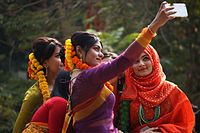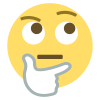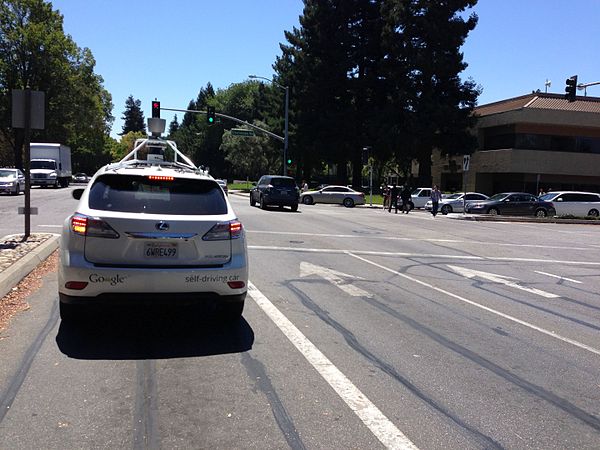Difference between revisions of "ICT student textbook/Introduction"
| (74 intermediate revisions by 5 users not shown) | |||
| Line 1: | Line 1: | ||
| + | [http://karnatakaeducation.org.in/KOER/index.php/ಐಸಿಟಿ_ವಿದ್ಯಾರ್ಥಿ_ಪಠ್ಯ/ಪರಿಚಯ ಕನ್ನಡ]{{Navigate|Prev=Preface|Curr=Introduction|Next=What is the nature of ICT}} | ||
| + | ===What is ICT=== | ||
| + | [[File:Bangladeshi girls taking Selfie at Pohela Falgun.jpg|thumb|200x200px|Girls taking a selfie]]Have you seen something like this? Can you tell what the girls are doing? | ||
| − | + | They are using a mobile phone to take a photo of themselves. Is there anything different about how they are doing this? Have you ever seen anyone in your school or community or home use a phone? Can you describe the things you have seen them do with a phone? | |
| + | [[File:49024-SOS-ATM.JPG|left|thumb|200x200px|Any Time Money!]]Look at this machine here - have you have seen something like this anywhere in your neighbourhood? Have you seen anyone use this machine? This is an ATM ([https://en.wikipedia.org/wiki/Automated_teller_machine Automated Teller Machine]), a machine from which you can get cash. Another full form for ATM is 'Any time money'. Usually the name of a bank will be mentioned on the ATM, example State Bank of Hyderabad ATM. | ||
| − | + | Are you thinking what is common between these two pictures? Let us find out.<br><br> | |
| − | === | + | {{clear}} |
| + | ===={{font color|purple|Think and write}}==== | ||
| + | Look at the table below and complete it. In the last column make a list of equipment and facilities you think you will need for doing these things. | ||
| + | {| class="wikitable" | ||
| + | |- | ||
| + | | style="width: 15%;" |[[File:Emojione 1F4DD.svg|left|thumb|100x100px|Think and write]] | ||
| + | | style="width: 50%;" | | ||
| + | {{font color|purple| ''Look at the list below and underline if you have done or seen or heard of these things''}} | ||
| + | * You have seen someone booking a gas cylinder refill through a phone. | ||
| + | * You have, or someone you know has, taken a photo of themselves taken for getting it printed on the ''Tirumala darshan'' ticket | ||
| + | * You have watched videos on your computer | ||
| + | * You have listened to songs on a phone. | ||
| + | * You have seen someone send chat messages on the phone | ||
| + | * You have seen people using a phone to make payments | ||
| + | | style="width: 35%;" | | ||
| + | |} | ||
| + | |||
| + | Compare the list you have made with your friends. What did you find? Now you may also be wondering how these things are done. | ||
| + | |||
| + | '''There is one common feature, which makes all these different things possible - the use of Information Communication Technologies, in short - ICT.''' | ||
| + | ICT refer to those set of technologies that help us create information, access information, analyze information and communicate with one another. | ||
| + | |||
| + | {| class="wikitable" | ||
| + | |- | ||
| + | | style="width: 10%;" |[[File:Emojione 1F914.svg|center|thumb|100x100px]] | ||
| + | | style="width: 90%;" |{{font color|Purple|''Is speech ICT? Is writing ICT? Is a book ICT? Is there anything special about ICT now?''}} | ||
| + | <br><br><br><br><br> | ||
| + | |} | ||
| + | |||
| + | Human beings have always gathered information and communicated, but what makes these present technologies special is their [[wikipedia:Digital|digital]] nature. In this textbook, we mean digital technologies or digital ICT when we refer to ICT. | ||
| + | |||
| + | Before we understand more about ICT, look at the list below and circle all the words that you have heard of:<br> | ||
| + | Have_you_heard_of_ICT_terms.mm | ||
| + | [[File:Have_you_heard_of_ICT_terms.mm|center]] | ||
| + | ''(If you are referring to the printed book, please open the file "Have_you_heard_of_ICT_terms.mm" on your computer using Freeplane).'' | ||
| + | |||
| + | As students, you may have been introduced to some of these terms in your school, in your family or in your neighbourhood. The cell phone tower, your nearest ATM, your mother's mobile phone, games, [[wikipedia:WhatsApp|Whatsapp]] chats, email, the [[wikipedia:Selfie|selfie]], internet, videos and songs on your computer - all these are examples of a new kind of ICT. These technologies are called [http://www.dictionary.com/browse/digital-technology digital technologies] and they are changing the way we talk to each other, work with each other, and the way we do things. The computer is becoming like a television, the phone is becoming like a computer, you can use the computer to make voice calls, you can record a video with your phone, you can read your newspaper on the phone, and you can even paint with your computer! The technologies that make these possible are called digital technologies, which is a new kind of ICT. | ||
| + | |||
| + | You can read more about how ICT developed, in the chapter on [[ICT_student_textbook/Science_Technology_and_Society|Science, Technology and Society]]. | ||
| − | + | ===We live in an information society=== | |
| + | Look at the pictures below and discuss with your friends and teacher. | ||
{| class="wikitable" | {| class="wikitable" | ||
|- | |- | ||
| − | | style="width: | + | | style="width: 60%;" |[[File:A Bonobo at the San Diego Zoo "fishing" for termites.jpg|left|thumb|600px|A Bonobo with a stick ]] |
| − | | style="width: | + | | style="width: 40%;" |What is the [[wikipedia:Bonobo|bonobo]] doing in this picture - can you guess? You are correct! It is "fishing" for termites from an ant hill. (Bonobo belongs to the same family as the chimpanzee and used to be called the pygmy chimpanzee). |
| − | + | <br>Did you think only human beings can fish? When it was first discovered in the 1920s that [[wikipedia:Chimpanzee|chimpanzees]] can make tools, all over the scientific community, people were amazed. This was because human beings were defined as the only species which makes tools for use, hence ability to make tools was seen as the essential distinction between human beings and animals. Dr Louis Leakey, a famous [https://en.wikipedia.org/wiki/Primatology primatologist] said " We have to define what is a tool, or we have to define what is a human being or we have to accept that chimpanzees are human beings!". | |
| + | |- | ||
| + | | style="width: 60%;" |[[File:Google self-driving Lexus SUV rear view.jpg|left|thumb|600px|Google car - can you see what is different? ]] | ||
| + | | style="width: 40%;" |What is special about this car? Did you guess? What is the meaning of self-driving car? Yes, it has no driver. | ||
| + | <br>When you drive, you gather information about the road, other vehicles, people, animals and weather and you operate the controls. Gathering information, processing, analyzing and acting, has been a defining characteristic of the human species. If a car can now do this, does it make the car a human being? What makes a human being special? | ||
|} | |} | ||
| − | + | To understand more about digital technologies are affecting how we learn and how we work, let us think of a small activity. | |
| + | ===={{font color|purple|Think and write}}==== | ||
| + | Let us say you are withdrawing money from a nearby ATM. Can you make a list of all the things you need to do for that? You need your account number, your [[wikipedia:Personal_identification_number|Personal Identification Number]] (PIN) and you need to enter the amount of money. When you put your card in the machine, it verifies your PIN, collects information about your bank account, the bank and the balance amount. The ATM machine does all of this, communicates with your bank and allows you to withdraw the money. | ||
| − | + | In the box below, can you list down three important words that come to your mind when you read about this? Can you draw a flowchart of how you think this activity could happen? | |
| − | = | + | {| class="wikitable" |
| + | |- | ||
| + | | style="width: 15%;" |[[File:Emojione 1F4DD.svg|left|thumb|100x100px|Think and write]] | ||
| + | | style="width: 85%;" | | ||
| + | <br><br><br><br><br> | ||
| + | |} | ||
| − | + | So many things we do now are based on collecting information, processing information, representing information and communicating information. Many devices - mobile phones, television, computers, tablets, cameras, scanners - collectively called ICT, have made this possible. How we collect information, how we analyze it, how we communicate the information and how we use the information to decide what to do are all very important. ICT and broadly digital technologies are changing the way we do things, thus making today's society an [[wikipedia:Information_society|information society]] . You may be familiar with the computer but now ICT have moved far beyond only the computer. As students you have to learn ICT to build your skills for functioning in the information society. | |
| − | + | ===What can you expect to learn=== | |
| + | ICT can help you create music, write poetry, learn mathematics or make videos. ICT can also help you in communicating with each other and learning together. This textbook has been developed to introduce you to all these activities. | ||
| + | |||
| + | In this new subject called ICT, we can expect to learn about ICT and how to work with ICT; this will be covered over 3 academic years. | ||
| + | |||
| + | ===== Knowledge ===== | ||
| + | This subject will introduce you to: | ||
#What is ICT | #What is ICT | ||
#How did ICT develop | #How did ICT develop | ||
| − | #Effect ICT | + | #Effect of ICT on family, neighbourhood, school and village/city |
| − | #Use of ICT safely and responsibly | + | #Use of ICT ethically, safely and responsibly |
| − | + | ||
| + | ===== Skill ===== | ||
| + | In this subject, through different hands-on activities and projects you will learn to: | ||
#Use ICT to express your ideas, using available resources (using images, audio, text, videos) | #Use ICT to express your ideas, using available resources (using images, audio, text, videos) | ||
| − | #Use ICT | + | #Use ICT to learn school subjects and improve your general knowledge |
| − | #Use ICT | + | #Use ICT to talk to your friends, to work together and to play together |
| − | #Use ICT | + | #Use ICT in cultural activities and in the development of the local community. |
| − | |||
| − | |||
| − | |||
| − | |||
| − | + | As students, you are encouraged to explore this new area and make connections to your own daily life, the impact these ICT have on your life, how you would like to work with this technology and how you can equip yourself to understand this new way of thinking, learning and communicating. | |
| − | === | + | ===How is this book organized=== |
| − | # | + | The textbook has 5 units, for five themes of ICT learning: |
| − | + | # [[ICT student textbook/What is the nature of ICT|What is the nature of ICT]] | |
| + | # [[ICT student textbook/Data representation and processing|Data representation and processing]] | ||
| + | # [[ICT student textbook/Communication with graphics|Communication with graphics]] | ||
| + | # [[ICT student textbook/Audio visual communication|Audio visual communication]] | ||
| + | # [[ICT student textbook/Educational applications for learning your subjects|Learn your school subjects]] | ||
| + | * There is an overview section which has an overall introduction for each of the units. This overview for each unit is for you to get a complete view of what are the various aspects you will learn in that unit. These aspects will be then covered level-wise. Some of these ideas may be unfamiliar in the beginning, you could revise them after you finish the level-wise activities. | ||
| + | * Each unit has a brief introduction followed by hands-on (meaning practical work with your computer) activities for each unit / theme. These units will have activities at three different levels, as you move from class 6-8. Different ICT devices (hardware) and applications (software) will be used for the activities. Your teacher will show you how to use these ICT devices and applications. Instructions for learning applications are available [[Explore an application|here]]. You can visit these pages to learn about these applications, which you will use for some of the activities in this book. | ||
| + | * Your teacher will determine the appropriate level of activity. She will introduce a new unit or an activity with a demonstration. This will be followed by activities for you. These activities could include some projects and will involve individual or group work. | ||
| + | * You can work individually or in groups or read the textbook and discuss in the classroom. Different groups in the class will work on different examples for a given theme and share your analysis, findings and creations. You will learn together and also teach one another! | ||
Latest revision as of 09:04, 30 May 2019
What is ICT
Have you seen something like this? Can you tell what the girls are doing?
They are using a mobile phone to take a photo of themselves. Is there anything different about how they are doing this? Have you ever seen anyone in your school or community or home use a phone? Can you describe the things you have seen them do with a phone?
Look at this machine here - have you have seen something like this anywhere in your neighbourhood? Have you seen anyone use this machine? This is an ATM (Automated Teller Machine), a machine from which you can get cash. Another full form for ATM is 'Any time money'. Usually the name of a bank will be mentioned on the ATM, example State Bank of Hyderabad ATM.
Are you thinking what is common between these two pictures? Let us find out.
Think and write
Look at the table below and complete it. In the last column make a list of equipment and facilities you think you will need for doing these things.
|
Look at the list below and underline if you have done or seen or heard of these things
|
Compare the list you have made with your friends. What did you find? Now you may also be wondering how these things are done.
There is one common feature, which makes all these different things possible - the use of Information Communication Technologies, in short - ICT. ICT refer to those set of technologies that help us create information, access information, analyze information and communicate with one another.
| Is speech ICT? Is writing ICT? Is a book ICT? Is there anything special about ICT now?
|
Human beings have always gathered information and communicated, but what makes these present technologies special is their digital nature. In this textbook, we mean digital technologies or digital ICT when we refer to ICT.
Before we understand more about ICT, look at the list below and circle all the words that you have heard of:
Have_you_heard_of_ICT_terms.mm
File:Have you heard of ICT terms.mm
(If you are referring to the printed book, please open the file "Have_you_heard_of_ICT_terms.mm" on your computer using Freeplane).
As students, you may have been introduced to some of these terms in your school, in your family or in your neighbourhood. The cell phone tower, your nearest ATM, your mother's mobile phone, games, Whatsapp chats, email, the selfie, internet, videos and songs on your computer - all these are examples of a new kind of ICT. These technologies are called digital technologies and they are changing the way we talk to each other, work with each other, and the way we do things. The computer is becoming like a television, the phone is becoming like a computer, you can use the computer to make voice calls, you can record a video with your phone, you can read your newspaper on the phone, and you can even paint with your computer! The technologies that make these possible are called digital technologies, which is a new kind of ICT.
You can read more about how ICT developed, in the chapter on Science, Technology and Society.
We live in an information society
Look at the pictures below and discuss with your friends and teacher.
| What is the bonobo doing in this picture - can you guess? You are correct! It is "fishing" for termites from an ant hill. (Bonobo belongs to the same family as the chimpanzee and used to be called the pygmy chimpanzee).
| |
| What is special about this car? Did you guess? What is the meaning of self-driving car? Yes, it has no driver.
|
To understand more about digital technologies are affecting how we learn and how we work, let us think of a small activity.
Think and write
Let us say you are withdrawing money from a nearby ATM. Can you make a list of all the things you need to do for that? You need your account number, your Personal Identification Number (PIN) and you need to enter the amount of money. When you put your card in the machine, it verifies your PIN, collects information about your bank account, the bank and the balance amount. The ATM machine does all of this, communicates with your bank and allows you to withdraw the money.
In the box below, can you list down three important words that come to your mind when you read about this? Can you draw a flowchart of how you think this activity could happen?
|
|
So many things we do now are based on collecting information, processing information, representing information and communicating information. Many devices - mobile phones, television, computers, tablets, cameras, scanners - collectively called ICT, have made this possible. How we collect information, how we analyze it, how we communicate the information and how we use the information to decide what to do are all very important. ICT and broadly digital technologies are changing the way we do things, thus making today's society an information society . You may be familiar with the computer but now ICT have moved far beyond only the computer. As students you have to learn ICT to build your skills for functioning in the information society.
What can you expect to learn
ICT can help you create music, write poetry, learn mathematics or make videos. ICT can also help you in communicating with each other and learning together. This textbook has been developed to introduce you to all these activities.
In this new subject called ICT, we can expect to learn about ICT and how to work with ICT; this will be covered over 3 academic years.
Knowledge
This subject will introduce you to:
- What is ICT
- How did ICT develop
- Effect of ICT on family, neighbourhood, school and village/city
- Use of ICT ethically, safely and responsibly
Skill
In this subject, through different hands-on activities and projects you will learn to:
- Use ICT to express your ideas, using available resources (using images, audio, text, videos)
- Use ICT to learn school subjects and improve your general knowledge
- Use ICT to talk to your friends, to work together and to play together
- Use ICT in cultural activities and in the development of the local community.
As students, you are encouraged to explore this new area and make connections to your own daily life, the impact these ICT have on your life, how you would like to work with this technology and how you can equip yourself to understand this new way of thinking, learning and communicating.
How is this book organized
The textbook has 5 units, for five themes of ICT learning:
- What is the nature of ICT
- Data representation and processing
- Communication with graphics
- Audio visual communication
- Learn your school subjects
- There is an overview section which has an overall introduction for each of the units. This overview for each unit is for you to get a complete view of what are the various aspects you will learn in that unit. These aspects will be then covered level-wise. Some of these ideas may be unfamiliar in the beginning, you could revise them after you finish the level-wise activities.
- Each unit has a brief introduction followed by hands-on (meaning practical work with your computer) activities for each unit / theme. These units will have activities at three different levels, as you move from class 6-8. Different ICT devices (hardware) and applications (software) will be used for the activities. Your teacher will show you how to use these ICT devices and applications. Instructions for learning applications are available here. You can visit these pages to learn about these applications, which you will use for some of the activities in this book.
- Your teacher will determine the appropriate level of activity. She will introduce a new unit or an activity with a demonstration. This will be followed by activities for you. These activities could include some projects and will involve individual or group work.
- You can work individually or in groups or read the textbook and discuss in the classroom. Different groups in the class will work on different examples for a given theme and share your analysis, findings and creations. You will learn together and also teach one another!





